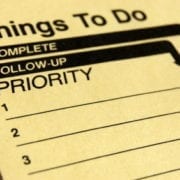11 Ideas for Economic Recovery
Finding opportunity in the down economy
Pick any sector right now, and what do you see? People and businesses are looking for opportunities. What kinds of opportunities? Real estate investments, undervalued stocks, strategic partnerships, you name it. The one pervading message we’re hearing lately is that organizations are watching for the economic recovery to start soon and looking for ways to come out of this down cycle stronger than before.
One retail CTO summed it up well at a recent SAS event when he said, “We don’t want to just struggle through and be hanging by our fingertips when the economy recovers. We want to come out strong.” Thinking long-term has led this retailer’s CEO to investigate real estate purchases at lower rates and to buy up high-end equipment now while the prices are low.
Where can you find long-term strategies for your business? Consider these 11 ideas from the Radical Times Webcast series by SAS Marketing Director Jonathan Hornby:
1. Remember, recessions make us stronger. According to economist Carl Schramm, recessions are part of the normal cycle. They make us stronger and force us to concentrate on strengths. It may be survival of the fittest, but it is never too late to put your house in order.
2. Beware cascading consequences. Joel Barker, futurist and author, warns about unintended consequences. The moment a plan or initiative is executed, you get a ripple of cascading consequences – some good, others bad. Unfortunately, few organizations consider the ripple effects up front. A decision that delivers positive first-order consequences could very well lead to negative second- or third-order events.
3. Understand what creates value. Alarmingly, recession or not, many organizations destroy 400 percent of the previous year’s profit without even realizing it. Peter Turney, CEO of Cost Technology, suggests using activity-based management techniques to recognize which business activities and which customers are causing a drain on your bottom line. Once you know, rebalance or change your strategy to deliver optimum returns.
4. Improve productivity. According to productivity expert Tor Dahl, only 8 percent of what we do at work is deemed perfect from a productivity point of view. As Dahl puts it, there are various “logs” that stand between us and our objectives. Remove them and you will find more time to focus on innovation. Start by asking a simple question: What am I doing that no one in this organization should be doing?
5. Get strategic. Gabor George Burt encourages organizations to defy conventional wisdom, and then simultaneously pursue a differentiated strategy with lower costs. When done correctly, you move from a bloody red ocean of competition to a calm blue ocean of opportunity. As an example, look to the Nintendo Wii, a gaming platform that sought to attract 90 percent of the population instead of the 5 percent targeted by the traditional gaming community – all at a lower cost.
6. Innovate quickly. Joel Barker says you can innovate faster, cheaper and with less risk by developing innovations at the verge. To do this, combine two separate things to create a totally new offer that addresses an unmet need. The gift bag, which combines brown bags and gift wrap, is a great example. There are probably millions of other combinations waiting to be discovered.
7. Innovate constantly. No innovation lasts forever, says author and business advisor Geoffrey Moore. You have to understand the innovation life cycle. It starts by defining your company’s core and context – core being what truly differentiates you. With that understanding, focus on how you will continuously recycle resources from invention to deployment, management, offloading and back.
8. Be extraordinary. Kevin Freiberg has discovered that ordinary people can achieve extraordinary results. It starts by creating a culture that encourages employees to do what’s right for the customer. For one employee at Wegmans, it was about challenging what was on offer in his deli. For Southwest Airlines, it was about how they could maintain the current schedule with fewer planes.
9. Keep it simple. Author Mark Thompson would encourage you to go back to basics and give customers just what they want: simple offers that exceed expectations. For example, one-click access to thousands of mutual funds, or exceptional service for the price paid. When setting expectations, always under-commit and over-deliver.
10. Focus on return on customer. Your customers are a finite resource, says Martha Rogers, Founding Partner of Peppers & Rogers Group. If you budget and reward employees based on the long-term value of customers, you will protect your organization today and well into the future. One Canadian bank applied this thinking to bounced checks. Instead of charging “good” customers to meet fee income targets, they sent notes asking them to deposit additional funds. The propensity for that customer to do business with them in the future went through the roof.
11. Lead to breed success. According to entrepreneur Gary Hoover, there are eight keys to building success, starting with a leader’s curiosity. Study history; few ideas are truly new. Look to the founding era of your industry and identify best practices that became too expensive to maintain during the ‘60s and ‘70s. Technology can probably breathe new life into them.
This article was republished with the permission of sascom Magazine.
About the Author












Your 11 ideas for economic-recovery is just rhetoric, any real ideas?